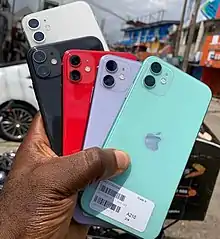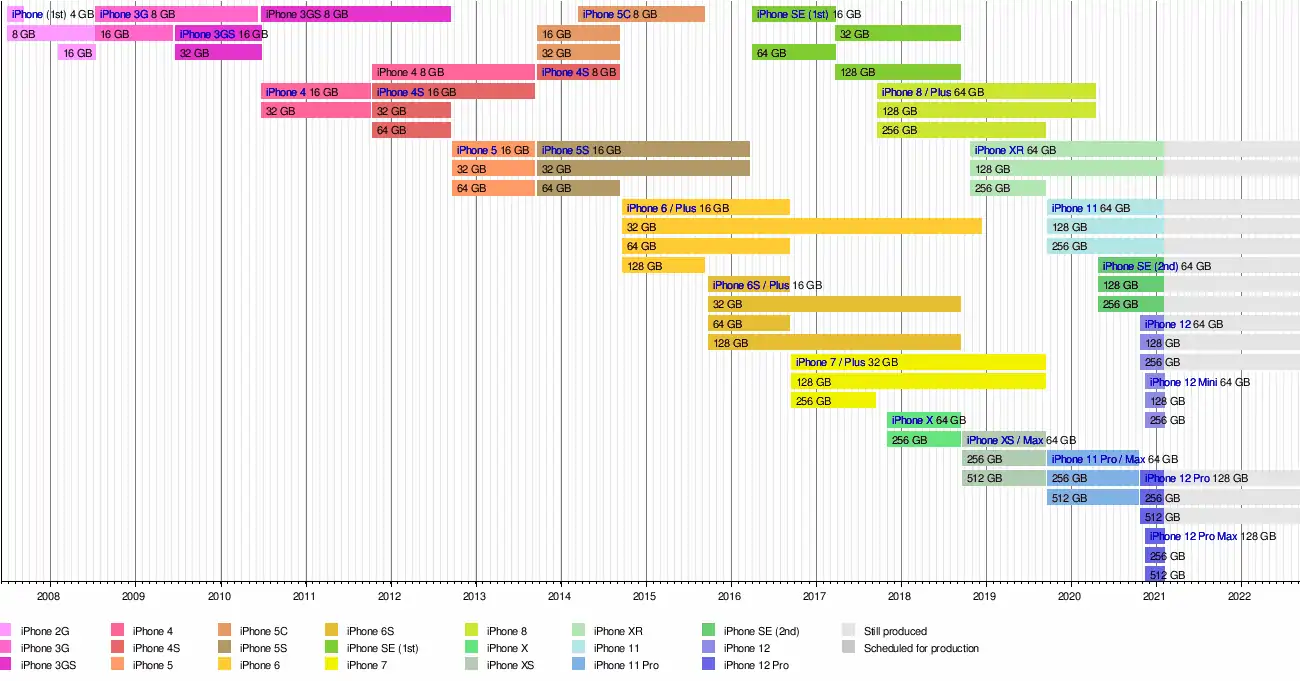iPhone 11
The iPhone 11 is a smartphone designed, developed, and marketed by Apple Inc. It is the thirteenth generation lower-priced iPhone, succeeding the iPhone XR. It was unveiled on September 10, 2019, alongside the higher-end iPhone 11 Pro flagship at the Steve Jobs Theater in Apple Park, Cupertino by Apple CEO Tim Cook. Pre-orders began on September 13, 2019, and the phone was officially released on September 20, 2019, one day after the official public release of iOS 13.
 An iPhone 11 in White | |
| Brand | Apple Inc. |
|---|---|
| Manufacturer | |
| Slogan | Just the right amount of everything. |
| Generation | 13th |
| First released | September 20, 2019 |
| Availability by region | September 20, 2019
September 26, 2019
September 27, 2019
October 25, 2019
October 26, 2019
November 1, 2019
December 6, 2019
|
| Predecessor | iPhone XR |
| Successor | iPhone 12 / iPhone 12 mini |
| Related | iPhone 11 Pro/iPhone 11 Pro Max iPhone SE (2nd generation) |
| Type | Phablet |
| Form factor | Slate |
| Dimensions | H: 150.9 mm (5.94 in) W: 75.7 mm (2.98 in) D: 8.3 mm (0.33 in) |
| Mass | 194 g (6.8 oz) |
| Operating system | Original: iOS 13 Current: iOS 14.4, released January 26, 2021 |
| System on chip | A13 Bionic |
| Modem | Dual SIM with eSIM Intel[1] Gigabit-Class LTE, up to 30 LTE bands |
| Memory | 4 GB LPDDR4X RAM |
| Storage | 64, 128 or 256 GB |
| Battery | 3.83 V 11.91 Wh (3110 mAh) Li-ion[2] |
| Charging | Fast charging, Qi wireless charging |
| Display | 6.1 in (150 mm) Liquid Retina: LED-backlit IPS LCD, 1792×828 px (326 ppi) 625 cd/m2 max. brightness (typical), with dual-ion exchange-strengthened glass and Haptic Touch. |
| Rear camera | 12 MP (1.4 μm) (1/2.55″) Sony Exmor IMX333-Inspired, quad-LED flash, ƒ/1.8 aperture, Optical image stabilization (Wide-angle only) quad-LED flash, autofocus, IR filter, Burst mode, Five‑element lens (Ultra Wide);[3] six‑element lens (Wide),[3] 4K video recording at 24, 30 or 60 FPS or 1080p at 30 or 60 FPS, Slow-motion video (1080p at 120 FPS or 240 FPS), Time-lapse with stabilization, Panorama (up to 63 megapixels), Portrait Mode, Portrait Lighting, Face detection, Digital image stabilization, Optical image stabilization, Stereo audio recording, Night Mode |
| Front camera | 12 MP, f/2.2 aperture, burst mode, exposure control, face detection, auto-HDR, auto image stabilization, Retina flash, 4K video recording at 24, 30 or 60 FPS or 1080p HD at 30 or 60 FPS, Slow-motion video (1080p at 120 FPS) Portrait Mode, Portrait Lighting and Animoji |
| Sound | Spatial Audio, Dolby Atmos |
| Connectivity | Wi-Fi 6 (802.11ax) |
| Water resistance | IP68, up to 2 m (6.6 ft) for 30 minutes |
| Other | FaceTime audio- or video-calling, USB-C to Lightning |
| Website | www Archived at the Wayback Machine on October 13, 2020 web |
| References | [4] |
| This article is part of a series on the |
| iPhone |
|---|
| List of iPhone models |
The prominent changes compared with the iPhone XR are the Apple A13 Bionic chip, and an ultra-wide dual camera system.[5] While the iPhone 11 Pro comes with an 18 W Lightning to USB-C fast charger, the iPhone 11 comes with the same 5 W charger found on previous iPhones, even though the 18 W charger is compatible with both models.[6][7]
History
Details regarding the smartphone were widely leaked before the official release. Complete specifications and renderings of the phone were publicized, many of which turned out to be correct, such as advancements in the camera and retainment of the 'notch' design around the frontal camera featured since the iPhone X.[8][9][10] The official event invite sent out to developers, which contained a graphic featuring an Apple logo made of layered colored glass, suggested new colors for the phone. A patent filed by Apple earlier in the year also hinted at a new camera design.[11][12]
Design
The iPhone 11 is available in six colors: Purple, Yellow, Green, Black, White, and Product (Red). There is a notch at the front for the TrueDepth camera system and speaker, similar to its predecessor, the iPhone XR. There is a bump in the back for the cameras and the flash that is the same size as the iPhone 11 Pro, although the iPhone 11 only has two cameras compared to the Pro's three cameras.[7][4] Also, the iPhone 11 has a matte glass rear camera housing and glossy glass back, while the iPhone 11 Pro has a glossy glass rear camera housing and matte glass back. The Apple logo is now centered on the back of the device with no text, a change from previous models.

| Color | Name |
|---|---|
| Black | |
| White | |
| Purple | |
| Yellow | |
| Green | |
| Product (Red) |

Specifications
Hardware
The iPhone 11, along with the iPhone 11 Pro, uses Apple's A13 Bionic processor, which contains a third-generation neural engine. It has three internal storage options: 64 GB, 128 GB, and 256 GB.[13] It also has 4 GiB of RAM.[14] The iPhone 11 has an IP68 water and dust-resistant rating along with dirt and grime, and is water-resistant up to two meters for 30 minutes. However, the manufacturer warranty does not cover liquid damage to the phone. Also, like previous iPhones, both phones do not have a headphone jack, and come with wired EarPods with a Lightning connector.[7][14] The iPhone 11 is the first smartphone with built-in ultra-wideband hardware, via its Apple U1 chip.[15][16][17]
Display
The iPhone 11 has a 6.1 in (15.5 cm) IPS LCD, unlike the Pro models which have OLED displays.
The resolution is 1792 × 828 pixels (1.5 megapixels at 326 ppi) with a maximum brightness of 625 nits and a 1400:1 contrast ratio. It supports Dolby Vision, HDR10, True-Tone, and wide color gamut. As with the iPhone 11 Pro, XR, XS, and X, the display has a notch at the top for the TrueDepth camera system and the speaker. The display has an oleophobic coating that is fingerprint-resistant.[7][14] Apple announced in September 2019 that both the iPhone 11 and iPhone 11 Pro would show a warning notification if a display was replaced with an unauthorized part. Apple stated that problems with the phone could arise if the wrong parts or procedures were used during the repair process.[18]
Camera
The iPhone 11 includes a dual-lens 12 MP rear camera array. There is one ƒ/2.4 ultra wide angle lens with a 120 degree field of view and 2× optical zoom out, and one ƒ/1.8 wide angle lens. The iPhone 11 supports 4K video at up to 60 fps and 1080p slow motion at up to 240 fps.[7] The phone also features an audio zoom feature which focuses audio on the area that is being zoomed in on, similar to the Pro model.[14] Both of the cameras support video although only the primary lens has OIS. It supports Portrait Mode with six (6) portrait lighting effects, depth control, and an advanced bokeh effect. The phone also has an automatic Night Mode allowing the camera to take brighter pictures with reduced noise in low light environments. There is also a redesigned camera app that adds new features such as a scroll wheel for choosing between the different lenses and a feature called "QuickTake", which allows the user to long-press the shutter button to take a video. Apple has also announced a new Deep Fusion feature which takes advantage of AI and machine learning for image processing and was released via iOS 13.2 software update on October 29.[7][14][19]
Software
The iPhone 11 was supplied with iOS 13,[20] which includes Siri, Face ID (through the TrueDepth camera), Apple Pay, and supports Apple Card. As of September 16, 2020, the iPhone 11 is now compatible with iOS 14.
Reception
The iPhone 11 drew generally positive reviews after its launch.[20][21] Reviews generally praised the phone's performance, battery life, and cameras, while criticizing the display as passable, but aging quickly. Reviewers also criticized the notch as being far too large for 2019. According to Counterpoint Research's Market Pulse, it was the second best-selling model globally for 2019, in less than four months of launch.[22]
Controversy
Power Adapter & EarPods
Apple, through an environmental initiative, has removed the EarPods and power adapter from all new iPhone boxes starting October 2020, including the iPhone 11. It is claimed that removing these items will reduce e-waste and permit a smaller iPhone box, allowing more devices to be transported simultaneously to decrease carbon footprint. However, Apple now includes a USB-C to Lightning cable, incompatible with the existing USB-A power adapters that Apple previously supplied with their devices. Upgraders can still use their existing iPhone power adapters and cables, but users wanting fast charging capabilities will have to purchase a USB-C power adapter separately.[23]
References
- Sascha Segan (September 17, 2019). "Confirmed: iPhone 11 Series Phones Have Intel Modems". PCMag.
- Humphries, Matthew (September 18, 2019). "iPhone 11 Battery Sizes Confirmed". PC Magazine. Retrieved September 18, 2019.
- Holt, Kris (September 10, 2019). "iPhone 11's dual-camera system has an ultra-wide lens". Engadget. Retrieved March 13, 2020.
- "iPhone 11 Pro and Pro Max unveiled at Apple event". Apple Inc. Retrieved September 10, 2019.
- Murphy, Samantha. "iPhone 11 Pro and Pro Max unveiled at Apple event". CNN Business. Retrieved September 10, 2019.
- "Apple finally includes a fast charger with the iPhone 11 Pro". Engadget. Retrieved September 10, 2019.
- "iPhone 11 - Technical Specifications". Apple Inc. Retrieved September 11, 2019.
- phones, Gareth Beavis 2019-08-15T21:18:23Z Mobile. "New iPhone 11 release date, price, news and leaks". TechRadar. Retrieved August 17, 2019.
- Griffin, Andrew (August 22, 2019). "Apple is about to launch a huge range of new products – here's what they are". The Independent. Retrieved August 27, 2019.
- "iPhone 11: release date, price and leaks for the new iPhone". WhatHiFi. Retrieved August 27, 2019.
- Curtis, Sophie (September 2, 2019). "iPhone 11 launch date confirmed as Apple sends out invitation to 'special event'". mirror. Retrieved October 16, 2019.
- Brown, Mike. "iPhone 11: Apple Event Invite May Hint at the Future of Smartphone Cameras". Inverse. Retrieved October 16, 2019.
- 1 GB = 1 billion bytes
- "Apple iPhone 11 - Full phone specifications". www.gsmarena.com. Retrieved September 10, 2019.
- Snell, Jason (September 13, 2019). "The U1 chip in the iPhone 11 is the beginning of an Ultra Wideband revolution". sixcolors.
- "How Apple's U1 Chip Adds Amazing New Capabilities to the iPhone". pocketlint.
- Barrett, Brian (September 12, 2019). "The Biggest iPhone News Is a Tiny New Chip Inside It". Wired.
- Welch, Chris. "Apple's iPhone 11 and 11 Pro will show a warning on your lock screen if they can't verify a replaced screen". The Verge. Retrieved September 26, 2019.
- Evans, Jonny (September 12, 2019). "iPhone 11: What is Deep Fusion and how does it work?". Computerworld. Retrieved September 13, 2019.
- Goode, Lauren. "Review: Apple iPhone 11". Wired. Retrieved November 1, 2019.
- Axon, Samuel. "iPhone 11 review: The most attractive choice in Apple's best lineup in years". arstechnica. Retrieved November 1, 2019.
- "Apple iPhone XR became top-selling model globally for 2019: Counterpoint Research". Free Press Journal. Retrieved March 2, 2020.
- "iPhone 12: Apple's muddled charger messaging". iMore. October 15, 2020. Retrieved November 5, 2020.
- Apple Inc. (2007–2020). iPhone News - Newsroom Archive. Retrieved July 23, 2020.
External links
- iPhone 11 – official site
| Preceded by iPhone XR |
iPhone 13th generation alongside iPhone 11 Pro / Pro Max |
Succeeded by iPhone 12 / 12 mini |

